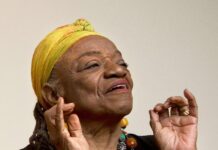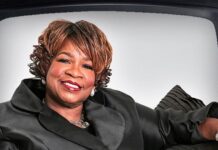
*As we celebrate Black History Month and the contributions of African Americans around the globe, actor and cultural architect Charles Reese reflects on his work surrounding James Baldwin, one of the most prolific literary giants of the 20th century. Known as one of the modern-day authorities of Baldwin’s work, Reese shares his favorite works by the man who not only changed his life but how he views the world.
[This interview has been edited and condensed for clarity].
Gwendolyn Quinn: Tell me about your experience growing up in the Nation’s Capital.
Charles Reese: I grew up in the Northwest section of Washington, D.C., in the Shaw district. It was a great neighborhood where people looked out for each other. I went to Scott Montgomery Elementary School, Shaw Junior High, and I graduated from McKinley Tech High School.
My family attended Old Samaritan Baptist Church. We went to church every Sunday, and on Saturdays we had dinners there. The storefront church was located across the street from Mosque #2. That’s what made our neighborhood unique, I played with the Muslims during the week, but when we went to church on Sunday, we went on one side, and they went on the other side.
We [Shaw community] had our ups and downs like any other village, but it was a safe place for me, and I found out who I was as a young kid.

GQ: When did you fall in love with theater and acting?
CR: It started at Old Samaritan Baptist Church. One of the things that we regularly did was recite Bible scripture and poems before the congregation. We had Easter and Sunday programs. I think that’s where it started for me. Then, it moved on to Scott Montgomery Elementary School with my sixth-grade teacher, Lillian Fulp, who was also my favorite teacher. She introduced me to Langston Hughes. I participated in poetry competitions at Scott Montgomery.

GQ: When did you fall in love with James Baldwin?
CR: I fell in love with James Baldwin by the time I got to Morehouse College. I met Mr. Baldwin when I was a freshman student. It was a brief encounter. I was coming across the campus at Morehouse, and I ran into him. He looked at me; I looked at him. He said, “My, you have eyes like mine.” I said, “Thank you, Sir,” and I ran.
Let me explain why I ran. I knew who Baldwin was, but I ran because at the time I was trying to make my curfew. There was a murder case going to trial, the Atlanta Child Murders, and Wayne Williams was the suspect. James Baldwin was in Atlanta to investigate the case for a story.
That was the only time I met him. What’s so ironic about that is, I started reading more Baldwin after that encounter. By the time I graduated I had read so much Baldwin, I had to go to Paris to find him.

GQ: How has James Baldwin impacted you personally and professionally?
CR: Baldwin’s writings had a profound impact on me. He was someone that I could read and be in tune with my soul. “The Fire Next Time” was the work that touched me the most. For one, it was the letter he wrote to his thirteen-year-old nephew, James Baldwin. When I first read it, I was like, “Oh, he’s talking about me.”
“The Fire Next Time” talks about how as a black person, I’m expected to live and navigate in this country. In his works like “Tell Me How Long the Train’s Been Gone” and the first book I read, “Go Tell It on the Mountain,” related to me as well. At the time I read the book [“The Fire Next Time”], it felt like some of my life in Washington, D.C. His books and work touched me in a way that ignited a fire in me.

GQ: How did the play, “James Baldwin, A Soul on Fire,” come about and when did you do the first production?
CR: “A Soul on Fire” is a two-character play. I am the main character of the production, and Forrest McClendon was the other actor in the show. “A Soul on Fire” was written by my Morehouse brother Howard B. Simon, who wanted to create a project for me.

“A Soul on Fire” came about when we read “James Baldwin: A Biography” by David Leeming. The book is excellent, and I highly recommend it to everyone. Howard and I discovered a chapter titled “Activist” [Chapter 22] about James Baldwin attending a secret meeting with the Attorney General, Robert F. Kennedy, in 1963. He brought Lorraine Hansberry, Lena Horne, and Harry Belafonte, along with Jerome Smith, a freedom rider, and Dr. Kenneth Clark, a sociologist and psychologist who worked on the Brown v. the Board of Education study in 1954 to help desegregate schools. That chapter inspired the play. We didn’t use Baldwin’s work in this play; we used the historical moment to tell our story, which is considered historical fiction.

The group came together to have a secret meeting about race relations in New York. It’s a day in the life of Baldwin getting ready for the meeting. A series of telephone conversations happened as he prepared to go. We debuted the production eighteen years ago off-Broadway. This year [2018] marks the eighteenth anniversary of “James Baldwin, A Soul on Fire.”
I received a wonderful New York Times review. The production was done by Woodie King of the New Federal Theatre. We did an eight-week production, and unfortunately, Howard died in the process. At that point, I became in charge of the play. We were also supposed to present in London, but unfortunately after 9/11 that did not happen.
I turned the play into a salon series which was part play, part conversation. For many years, I traveled around the country, and that’s how we’ve been able to keep the life source of the show for the past eighteen years.

GQ: I know that you edited the book version of the play, “James Baldwin, A Soul on Fire.” Who owns the play?
CR: Yes, I edited the book version of the play. Howard B. Simon is the playwright, and the play belongs to him. And since his death, I run the Howard B. Simon Estate.
I published the book in 2012, because usually when playwrights are alive, their works are published for resale. I released the book as a tribute to the twenty-fifth anniversary of Baldwin’s passing [1987].
The two-character play featured two commentaries from myself and Forrest McClendon. The book is now a part of Baldwin’s other related works. When I talk about Baldwin, I use the play as a tool.

GQ: Tell me about your inaugural essay, “James Baldwin: Artist as Activist, and The Baldwin Secret Summit of 1963.”
CR: I was invited by Furman University along with twelve other people to write an essay around Baldwin for a book [“James Baldwin: Challenging Authors”]. I decided to use the work I had written from my book. The essay allowed me to go into the historical context and explain why the meeting was important, and why people should take a look at it. This essay is a companion piece to the play, which I presented in Paris at the James Baldwin Conference in 2016.

GQ: How often is the James Baldwin Conference scheduled?
CR: The conference happens every two years. It started in London in 2006. There was supposed to be a conference in Turkey, this past year in 2017. Unfortunately, the organizers ended up postponing the conference.
GQ: How long have you attended the conference?
CR: The first time I attended the conference was in 2016. To attend, you must be selected. The year I was chosen, the organization added artists and musicians. Nearly 400 schools were participating from around the country. We spent three days dealing with nothing but James Baldwin. It’s incredible, and I’ve never experienced anything like that before. To be in the presence of people from all around the world focusing on one man; a black man who grew up in Harlem in 1924.

GQ: Tell me about your seven favorite Baldwin books. Please finish your thoughts on “The Fire Next Time.”
CR: “The Fire Next Time” is celebrating fifty-five years this year [2018]. The book was released in 1963 when the country was at its most fiery state. “The Fire Next Time” is one of the top fifty books in the Library of Congress. This is one of the first books I recommend that people read.


GQ: In 2014, the City of New York celebrated Baldwin’s ninetieth birthday. How were you involved in the celebration and tell me about that experience?
CR: The City of New York organized a year-long celebration. The family members were involved, and I was fortunate to be a part of it, including the street naming along with Trevor Baldwin. (By the way, Trevor Baldwin is also a Morehouse graduate).
GQ: Who runs the James Baldwin Estate?
CR: James Baldwin’s sister, Gloria Karefa-Smart runs the estate. Baldwin has eight brothers and sisters [Paula Whaley, Barbara Jamison, Ruth Crum, Elizabeth Dingle, Wilmer Baldwin, George Baldwin and David Baldwin]. Baldwin didn’t have any children. His nieces and nephews are taking up the charge and more involved in Baldwin’s affairs.

Baldwin’s niece, Aisha Karefa-Smart, is somewhat the spokesperson for the estate. I’ve worked with her and Trevor Baldwin. It appears that the younger generation of Baldwin-ites is emerging.
GQ: Tell me about “The Cross of Redemption.”
CR: “The Cross of Redemption” was referred to me by Aisha Karefa-Smart. I used some quotes in my essay [“James Baldwin: Artist as Activist, and The Baldwin Secret Summit of 1963”] from the book. “The Cross of Redemption” dealt with some essays that Baldwin wrote about that secret meeting and how he felt about the meeting. There are also uncollected stories, articles, and essays in this book that did not get published. Randall Kenan edited that book. It’s a lovely cornucopia of things on Baldwin that you’re not going to find in any other place.
GQ: Tell me about “James Baldwin: A Biography.”
CR: James Baldwin’s assistant, David Leeming, wrote the biography. David met Baldwin in Turkey, and he worked with him from 1963 to 1968. By the time Baldwin decided he wanted a biographer, David had received Baldwin’s blessings. “James Baldwin: The Biography” was released in 1994. It’s one of the definitive books on James Baldwin’s life. If you want to know who Baldwin is, David takes you through who Baldwin is through his work. It’s a great way to learn about Baldwin because you can pick it up and put it down when you want to.
I met David Leeming, and we lived around the corner from each other in Brooklyn. We used to have dinner and are friends to this day. He also wrote the foreword to my book, “James Baldwin, A Soul on Fire.”
David now lives upstate New York. We met during the time the play was running. He learned about me through the New York Times review; that’s how we became friends.

GQ: Tell me about the “Evidence of Things Not Seen.”
CR: “Evidence of Things Not Seen” is one of the last published books of Baldwin. The “Evidence of Things Not Seen” is when I met Baldwin. This book is about the Atlanta Child Murders. It’s a reportage book, Baldwin was hired by Playboy magazine to do a story on the Wayne Williams case that was getting ready to go to trial. The article turned into a book. He talks about the city of Atlanta, and who murdered the children. [The Atlanta Child Murders took place from 1979 to 1981. Wayne Williams was convicted of the murders of two black males. After the trial, the Atlanta Police Department announced that Wayne Williams was responsible for at least 23 out of the 29 murders. To this day, Wayne Williams maintains his innocence].
During that time, the city of Atlanta had its first Black mayor [Maynard Jackson], who was leaving office and Andrew Young was coming in as the new mayor. Baldwin talked about the forensic evidence that convicted Wayne Williams in 1982.
Baldwin took a look at the city and the entire arc. I suggest people take a look at it, because with all the things going on now with Black Lives Matter, “Evidence of Things Not Seen” represents the work that he did in the past, but as a nation, we are still witnessing a lot of the same societal ills that are happening today. And that’s why Baldwin is often referred to as a poetic prophet.

GQ: Talk about “Tell Me How Long the Train’s Been Gone.”
CR: “Tell Me How Long the Train’s Been Gone” is one of my favorite Baldwin books because it talks about the life of an actor. “Tell Me How Long the Train’s Been Gone” is about Baldwin and the relationship that he had with the Actors Studio [New York City] when they were producing one of his plays [“Blues for Mister Charlie”] on Broadway. The book is loosely based on that and Baldwin’s contention with the studio.
I hope one day that “Blues for Mister Charlie” and “Tell Me How Long the Train’s Been Gone” are adapted into films. One of Baldwin’s books, “If Beale Street Could Talk,” will be released this year [2018], and will be directed by Barry Jenkins, who won the Academy Award for “Moonlight.”
“If Beale Street Could Talk” is the second of Baldwin’s books that’s been adapted into a film. The only other book that’s been adapted to film is “Go Tell It on the Mountain,” which was done before he died back in the ‘80s.

GQ: Tell me about your seventh book choice, “Bearing Witness from Another Place.”
CR: “Bearing Witness from Another Place” is a pictorial essay book that was photographed by Sedat Pakay, who is now deceased. I met Sedat and have recordings that he shared with me a few years ago. “Bearing Witness from Another Place” includes pictures of Baldwin that you just won’t see.
Baldwin did a lot of work in Turkey, and he directed a play there. Baldwin met Sedat when he was a young student and later helped him get enrolled at Yale University, where he received his Master’s degree.

GQ: Why did James Baldwin like Turkey so much?
CR: Turkey was one of the places where he could go and write. I mean, one of the things about Baldwin that’s very important to note is that he left America in 1948 because of racism. He left because he said, “Listen, either I’m going to kill someone, or someone’s going to kill me.” He needed to get out.
Baldwin became the stranger in the village [Turkey]. That’s why we have the title, “Bearing Witness from Another Place.” The pictures were taken of him in Turkey.
Baldwin met a bunch of actors in Turkey who gravitated to him. Maya Angelou said it best about Baldwin. “People called Baldwin this ugly man; I thought he was beautiful.” When he got over to Europe, Maya said, “He became exotic.”
Baldwin went to Paris with the help of Richard Wright. He was then 24 years old and didn’t speak French, but he knew that’s where he needed to go. The war had happened in France, so everybody was free. People were open to having artists come there. Josephine Baker and Langston Hughes had gone over to Paris for a short period. All these black expats were over in Europe doing their thing. Some people stayed because of the war and never returned. Baldwin went to France.

GQ: You didn’t have “Giovanni’s Room” on your list, but let’s talk about that book.
CR: “Giovanni’s Room” is one of my favorites, too. I think “Giovanni’s Room” is the book that a lot of people talk about because it came after “Go Tell It on the Mountain.” He wrote, “Go Tell It on the Mountain” which is about his growing up in a church.
Then in 1956, he publishes this book about sexuality. “Giovanni’s Room” addresses all the things when it comes to homosexuality. It’s the story about two young white lovers, that’s the one book where he didn’t write about black people.
People always ask, “What about Baldwin’s sexuality?” He wrote “Giovanni’s Room” to say, “Hey I’m telling you what I know, what I experience.” He wrote about homosexuality in 1956, at a time when nobody wanted to publish it. The publishing company didn’t want to release it. He later found a company in London that published the book. “Giovanni’s Room” celebrated its sixtieth anniversary in 2016.
Now, everybody wants to read it. That shows where our country is and how things have evolved. Here is a black, openly gay man who wrote about it in 1956. Remember that was at a time when he could be killed immediately.


GQ: Tell me about the James Baldwin Conference in Paris at the American University of Paris.
CR: The American University of Paris in 2016 was celebrating their fiftieth anniversary. It’s an English-speaking school. We had people from Stanford University, Boston University, Morehouse College, Clark Atlanta University, and many other educational institutions and places across the United States and the world. We gathered in this one place to study Baldwin. I can’t emphasize how amazing that experience was to meet him for that brief period [Morehouse College] and years later to be invited to attend the conference. There were more than forty-two panels throughout the day. People were speaking at different sessions, and you could run from one end of the campus to the other. The college set-up was similar to New York University, and it’s located near the Eiffel Tower. We were also able to go on a tour and visit all of Baldwin’s spots.

My most favorite spot was the Le Select Café. That’s where Baldwin finished “Giovanni’s Room.” Le Select Café is an art deco café, and it still sits in the same community.

GQ: Tell me about the James Baldwin: Literary and Conversation Salon Series that you curate. How long has it been established?
CR: The James Baldwin Literary and Conversation Salon Series has been happening for five years. It started as a way for me to do book signings [“James Baldwin, A Soul of Fire”]. I thought it would be advantageous to not only read the book but perform excerpts from the book, too. Through the Salon Series, I’ve visited colleges, universities, and cultural arts institutions such as the Washington and Lee University, and Pasadena City College. I’ve also been invited to the California African American Museum and numerous libraries across the country including the Enoch Pratt Free Library in Baltimore. The D.C. Commission for the Arts and Humanities brought me for an appearance at Arena Stage. We also do private events at people’s homes and mansions. I do a great deal of those events in Los Angeles and Seattle.
GQ: What is your role in the Los Angeles Web Series Festival?
CR: I’m on the Board of Advisors for the Los Angeles Web Series Festival, which is the first web festival in the world. It started in Los Angeles with my good friend, Michael Ajakwe, Jr.

GQ: Tell me about “Crosswalk.”
CR: “Crosswalk” is a web show that I was developing with my dear friend Myla Churchill while I was living in Brooklyn, New York. Myla passed away from cancer in 2014, and I decided to move forward with the web series with plans to develop a television show. Her husband, Hassan Barrett, who is the executor of her estate, and I are working together on the project.

Myla taught at Long Island University [Brooklyn]. We went to undergrad together; she was at Spelman when I was at Morehouse. She got her Master’s degree from New York University, and I started working with her during that time.

I have a pattern for deceased writers. I have a mandate that my role as a cultural architect for public engagement is to continue these works of my fellow artists who are no longer with us. I work with their family members to keep the work moving forward. What happens to playwright’s work when they are gone? I learned through Baldwin, and of course, he has an estate that his family oversees. It is my responsibility to find ways to move the projects forward.

GQ: Tell me a few things that people may not know about James Baldwin.
CR: Baldwin was self-taught. I think most people don’t know that because people view him as an intellectual, but Baldwin did not go to college. He grew up surrounded by excellent teachers. He used to go to the library regularly and read everything. By the time he decided to go to Paris, he was already well read.
He loved to eat and sing, but he wasn’t the greatest singer. Baldwin recorded a spoken-word album, “A Lover’s Question,” that was released a few years after he passed. The album was produced by David Linx, who loved Baldwin and traveled with him to record the album, which is very good.

GQ: James Baldwin had a diverse group of friends. Tell us who some of those friends were?
CR: Everyone knows about his friendships with Nikki Giovanni, Maya Angelou, Toni Morrison, Richard Avedon, Lena Horne, Nina Simone, Langston Hughes, Richard Wright, Josephine Baker, Lorraine Hansberry, Sammy Davis, Jr., Medgar Evers, Martin Luther King, Jr., and Malcolm X, Alex Haley, Beauford Delaney, Jean Genet, Miles Davis, Ray Charles, Marlon Brando, Lee Strasberg, Charlton Heston, Huey P. Newton, Amiri Baraka, Harry Belafonte, Sidney Poitier, and Billy Dee Williams, among others.
GQ: What’s next for you with the James Baldwin projects?
CR: Baldwin has this quote, “You don’t tell life, life tells you.” I’m discussing some ideas with people in Amsterdam. My current residency project, “Know Your Baldwin,” is a partnership with ART ACTIVE, a nonprofit organization in Los Angeles. In April, on Fridays, I will spend ten weeks with eighth graders at the Audubon Middle School to teach them about Baldwin. “Know Your Baldwin” will run through June 2018. Is it a pilot program that I plan to take locally, nationally and internationally. I think eighth graders are a great place to start with Baldwin.
GQ: Outside of your James Baldwin projects, what other projects are in development?
CR: Last year [2017], I starred in “Beauty and Baller,” a web series that turned into a television series on Centric, now renamed BET Her. I developed another lecture series based on my nine-year experience with “Beauty and Baller” on how to sustain a career during the journey period from web series to television series.
I will continue to audition. And for the last five years, I’ve produced a lecture series at Pasadena City College. I work with students and professors to create conversation series throughout the school year. My brand is to take culture and art and turn it into financial gain.

Gwendolyn Quinn is an award-winning media strategist and consultant with a career spanning more than 25 years. She is a contributor to NBCNews.com/NBCBLK.com, BlackEnterprise.com, HuffPost, EURWEB.com, and Medium.com, among others. Quinn is also a contributor to Souls Revealed and Handle Your Entertainment Business.
We Publish News 24/7. Don’t Miss A Story. Click HERE to SUBSCRIBE to Our Newsletter Now!





